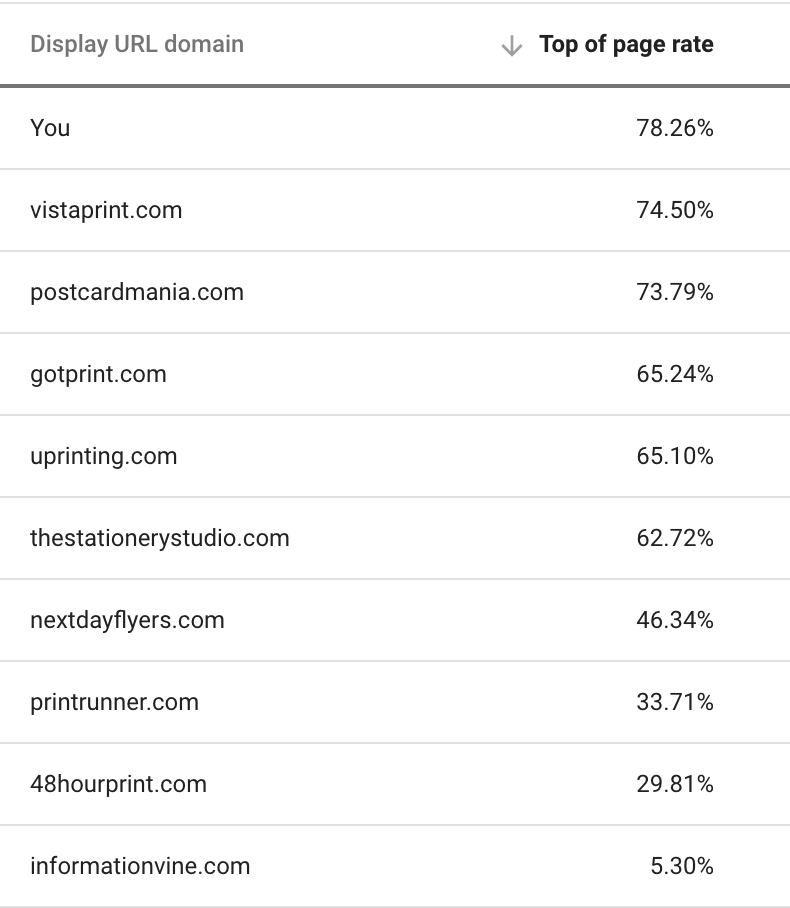
Two Google Ads Success Stories Through Negating Singular Product Queries
In my last article, I discussed a new Google Ads strategy for driving cost-efficient sales through close-variant negative keywords. This time, I’m covering more than just the benefits. This article breaks down two Google ads success stories and revisits the process for two everyday E-commerce businesses. The application and results of this strategy are investigated for two different industries and business problems so it can be utilized for your unique E-commerce PPC management.
Introduction: The dilemma with Google Ads & the printing industry
A company that sells custom recipe books was looking for ways to reach the right customer in the paid online advertising landscape. The company is primarily known for supplying custom fundraising merchandise to large-scale organizations. But the digital market was crowded with small B2C cookbook interest, and larger cookbook orders were difficult to close.
The company offers two types of cookbooks kits: individual and organizational. Requests for individual kits were in high demand, but these requests often didn’t lead to sales. Purchase intent from search traffic varied greatly, and ad targeting was difficult to refine.
The problem: Tapping into the right business leads in a B2B and B2C world
The interest online for individual cookbooks was consuming the budget of our client’s Google Ads account. Users were looking for personal cookbooks in small purchase quantities. Our client needed an E-commerce AdWords strategy to tap into businesses looking to purchase cookbooks in bulk.
While the company sells individual cookbooks, these sales are not profitable. Lead quality needed to improve and reflect larger orders from fundraisers, churches, and other businesses.
The solution: How we positioned ads to attract users searching for more than one cookbook
WebMechanix used a three-part strategy to position ads for the most qualified searches. We used close-variant negative keywords to set up strict search criteria and influence order size. This strategy requires:
- Focusing on singular and plural search terms.
- Specifying product quantity at the keyword level.
- Controlling search term quality with close-variant negatives.
1) Investigating search term variation
One glance at our client’s search term history revealed that users were searching keywords in various forms. Two of the most frequent variations were the singular and plural form of the keyword “cookbook.”
After discovering that these keywords were serving ads for both singular and plural product interest, WebMechanix investigated the performance of each variation. A few simple filters revealed that the client had spent $82,000 on search queries for the singular variation “cookbook” and only $14,000 on search queries for “cookbooks.”
Though singular interest drove an acceptable number of leads, the lead quality was questionable. The client was not generating an ROI from a market overrun by small-order interest. Our money was pouring into a PPC black hole.
2) Filtering by keywords & product quantity
Since small cookbook orders monopolized the search traffic, we bucketed our keywords into singular and plural ad groups to separate users with large-order purchase intent from users with individual purchase intent.
Specifying product quantity at the keyword level was just the start of our strategy. The next step was to ensure our ads showed exclusively to users who searched for more than one cookbook. Likewise, we needed ads for our singular ad group to appear only to users who wanted one cookbook.
3) Examining close-variant negative keywords
To filter our ads for the right user, we applied a singular “cookbook” negative keyword to the ad group driving plural search queries with plural keywords. This negative ensured we were not showing ads for close-variant searches that used “cookbook” in its singular form. Similarly, we applied a plural “cookbooks” negative to our singular ad group.
Google wants to show ads for as many variations of your keyword as possible. Unless you manually block your ads from showing for less profitable forms, the ads will show for:
- Past tense
- Present tense
- Future tense
- Plural and singular forms
- Other various suffixes
The results: Influencing order size & purchase intent
WebMechanix innovated a new process for measuring and improving our E-commerce client’s lead quality. Separating individual cookbook interest from larger order interest in real time led to three groundbreaking results.
167% increase in conversion rate
Within the 30-day period after the changes, plural searches drove a 20% conversion rate while singular searches drove a 12% conversion rate. Though the number of leads was lower than before, the value of the leads and their likelihood of turning into sales was much higher.

37% lower cost per lead
Leads interested in bulk purchases were converting at a cost of $12.17, which was 37% lower than before. With search volume half the size it once was, there were far fewer unqualified clicks. The higher lead quality contributed to a better ROI.

79% lower cost
Our ad group for larger cookbook orders spent only $48.68 over a one-month period. With less than $50 and 250 impressions, we drove four conversions. In this period, singular search terms spent almost 5x this cost, with a lower conversion rate than our ads showing for plural product interest.
The second dilemma: Google ads & the mailing industry
An online mailing company was looking for ways to reach the right customer in the paid advertising landscape. They create and deliver mail pieces for businesses without the hassle of sorting, labeling, applying postage, and transporting. But the online market was crowded with B2C interest, which made it challenging to target users with purchase intent.
With a small ad budget, offering printing and mailing services alongside well-known companies made advertising difficult. Our E-commerce client struggled to rank against the competition and reach buyers.
The problem: Drowning in keyword expenses
Mail products and services are competitive in a digital space. The Google ads network is oversaturated with ads for direct mail and every door direct mail. With a conservative budget, our E-commerce client needed to figure out how to show for some of the most expensive keywords in the industry.
There is a flood of search volume online for individual mail products, but this leads to only a few transactions. For the same terms, B2C search volume is much higher than B2B search volume. So how can we get in front of the right mail piece buyer affordably?
The solution: Excluding ads from users searching for a single mail product
WebMechanix used the same three-part Google adwords keywords tips to solve the problem.
1) Investigating search term variation
One glance at our client’s search term history revealed that users were searching for keywords in various forms. Two of the most frequent variations were the singular and plural form of specific mail products.
After discovering that these keywords were serving ads for both singular and plural product interest, WebMechanix investigated the performance of each variation. A few simple filters revealed that our E-commerce client had spent $20,800 on search queries for single mail products and $13,900 on search queries for multiple mail products. Ad impressions for single mail product searches reached 146,700, while searches for more than one mail product secured only 53,500 impressions.
Though single mail product interest drove some leads, the lead quality was questionable, and the client was not generating an ROI from that search intent. Our money was pouring into yet another black hole.
2) Filtering by keywords & product quantity
Since the keywords we targeted with ads had traffic mostly from people interested in individual mail products, we revised our keywords to target only mail products in their plural form. In doing so, we separated users with larger purchase orders from users with individual purchase intent. Segmenting product quantity at the keyword level was just step two of our three-step strategy…
3) Examining close-variants for Google shopping negative keywords
The final step was ensuring our plural keywords were showing ads exclusively to users who searched for more than one mail product. We would need to prevent our ads from appearing for any single mail product searches, since close-variant searches may slip through.
To position our ads for the right user, negative keywords for singular mail products were applied to our ad groups. This filtering ensured our ads would not show for close-variant searches that use specific mail products in singular form. Google likes to allow ads to appear for all search variations of a given keyword.
The results: yet another E-commerce success story
WebMechanix innovated a new process for positioning our E-commerce client’s ads in front of high-quality leads. By excluding our ads from people interested in individual solutions, we uncovered three groundbreaking findings.
Search impression share increased 40.17%
After collecting data for more than two weeks, we discovered that plural mail product searches drove a 40% increase in search impression share. Out of the 4,100 impressions generated, the most substantial increases in impressions occurred for pamphlets (+70.61%) and stationery cards (+48.80%). Though the number of clicks was lower than before, the value of each click and its likelihood of driving sales was much greater.
Top-of-page rate increased 137.7%
Before our efforts to remove singular queries, our Google ads were on the top of the search page no more than 55% of the time. After we added six close-variant negatives, the percentage rose to 78.26% in just 19 days. Since our search term requirements were particular, we were able to rank higher than several giant mailing competitors.

Average position improved 15.18%
Vistaprint may have the majority of impression share, but our client appeared at the top of search results more frequently. With search volume half the size it once was, there were far fewer unqualified impressions and clicks to be served. Our average position held stable at 2.1.
Although this isn’t perfect, it’s the highest we could achieve in a competitive online mailing market.

Noteworthy outcomes for both clients
Audience & budget control
Our unique testing strategy offered a B2B E-commerce cookbook client a way to get in front of the right prospects online at a more affordable cost. Two ad groups effectively separated higher intent users from unpredictable search interest. This categorization allowed the client to easily pause or enable ads for lower intent searches whenever they pleased.

Lead quality & competition
Our advanced negative keyword strategy offered our E-commerce client a way to improve ad rank and impression share for high-quality prospects. WebMechanix used close-variant keyword exclusions to separate high-intent prospects from those with unpredictable search interest. Blocking singular search terms reduced the chances that our ads would appear for irrelevant traffic tenfold. With a smaller budget than those of giant competitors, our client was able to rank higher and show for the most promising prospects.

Two major business problems, one solution
This article covered how close-variant negative keywords can correct some of the most common business problems in E-commerce PPC management. Whether you’re looking to expand efforts in a crowded market, trying to reach the right user, or hoping to rank with a limited budget, using the techniques above can help get the lead quality and ad visibility you’re looking for at a more affordable cost. Our first use case demonstrated how close-variant negative keywords can effectively separate purchase intent from less profitable user searches. Our second use case pushed ads above competitors without breaking the bank. Could close variant negative keywords be your next Google ads success story?
Learn how PPC helped a B2B nonprofit software company beat Fortune 500 competitors.
Most newsletters suck...
So while we technically have to call this a daily newsletter so people know what it is, it's anything but.
You won't find any 'industry standards' or 'guru best practices' here - only the real stuff that actually moves the needle.







